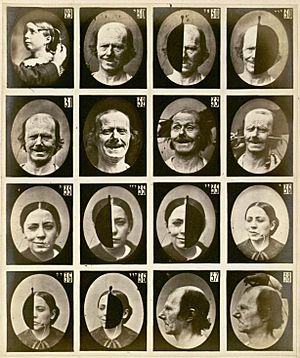Facial expression facts for kids

A facial expression is what happens when you move or hold the muscles in your face in a certain way. These movements show how a person is feeling to others around them. Facial expressions are a type of nonverbal communication, which means talking without words. They are a main way that humans share information about their feelings. Many other mammals and some other animal species also use facial expressions.
You can make a facial expression on purpose, like when you smile for a photo. But often, expressions happen without you even trying, because they are strongly linked to your emotions. Sometimes it's very hard to hide how you feel, even if you want to. For example, if you see something you really don't like, you might quickly show disgust on your face before you can make it look normal again. Interestingly, making a certain expression on purpose can sometimes even make you feel that emotion!
Some facial expressions can be understood by almost everyone, even by different kinds of animals. For example, anger and great happiness are often easy to spot. But other expressions can be tricky to understand, even with people you know well. For instance, it can be hard to tell the difference between disgust and fear.
Contents
What Are Facial Expressions?
Facial expressions are movements of your face muscles that show how you feel. They are a big part of how we communicate without speaking. Think about how you know if a friend is happy or sad just by looking at their face!
Why Do We Make Facial Expressions?
Our faces are like billboards for our feelings. When we are surprised, happy, or angry, our faces often show it right away. This helps people around us understand what we are experiencing. It's a quick way to share information, even across different cultures.
Voluntary and Involuntary Expressions
Sometimes we choose to make an expression, like when we pretend to be surprised at a party. This is called a voluntary expression. But most of the time, our expressions are involuntary. This means they happen automatically because of our emotions. For example, if you are really scared, your eyes might widen without you even thinking about it.
Understanding Different Expressions
While some expressions are easy to read, like a big smile for happiness, others can be confusing. For example, a frown might mean someone is sad, angry, or just thinking hard! Scientists study how people recognize different expressions and what they mean.
Common Facial Expressions
Here are some common feelings that people show with their faces:
- Anger: Often shown with furrowed brows and tight lips.
- Contempt: A feeling of looking down on someone, sometimes shown with one side of the lip curled up.
- Disgust: When something is unpleasant, often shown by wrinkling the nose.
- Fear: When you are scared, often seen with wide eyes and raised eyebrows.
- Happiness: Usually shown with a smile and crinkled eyes.
- Confusion: When you are puzzled, often with a furrowed brow or tilted head.
- Sadness: Often shown with downturned lips or tears.
- Surprise: When something unexpected happens, often with wide eyes and an open mouth.
Images for kids
-
An actor acting out Drama Masks (Thalia and Melpomene) in 1972.
See also
 In Spanish: Expresión facial para niños
In Spanish: Expresión facial para niños


